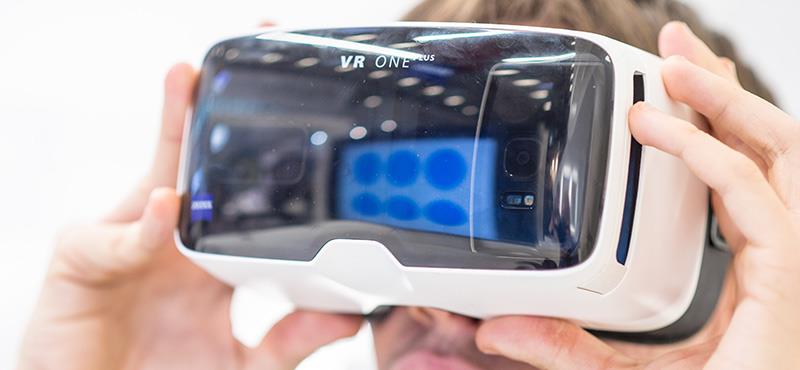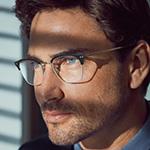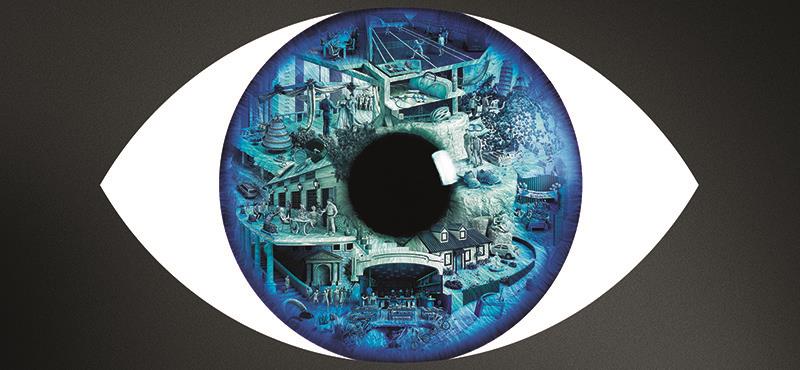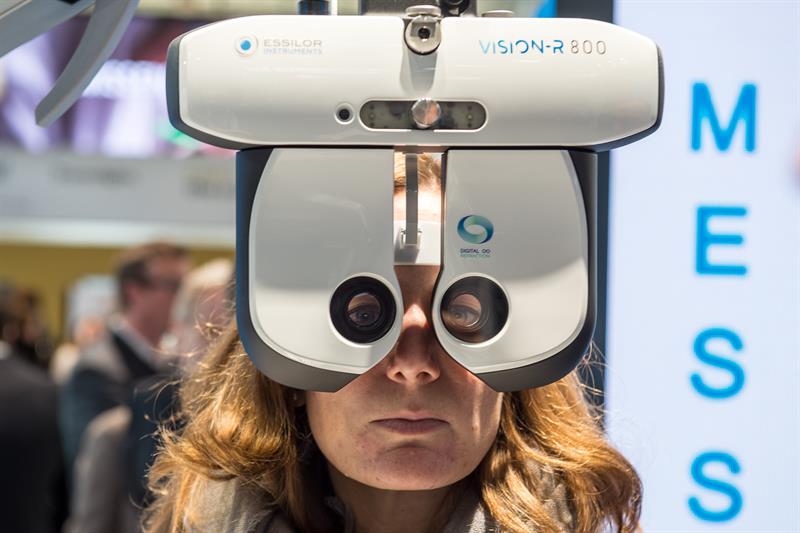Munich’s winter optifest has become associated with trends and technology but its international reach boasted volumes previously only seen at Silmo and Mido. Despite that, the head of press and public relations, Patrik Hof, insists Opti is about quality not quantity.
Opti is bucking the trend among the big international shows in that it continues to grow rather than contract and Hof suggests one reason may be that it is an all-encompassing show and not just a frames event. Munich’s transport connections and the Northern European’s liking for the city may also play a part, he says. Opti boasts more Scandinavian exhibitors than Paris or Milan. ‘There are many reasons,’ says Hof. ‘It’s like a puzzle: it has to have all the parts and they have to fit together.’
One of the first pieces of that giant Germanic puzzle was Carl Zeiss. Its stand took the gleaming white techno feel to the max as it showcased its forthcoming Visuconsult concept. It’s not a single product, explains Joachim Kuss, director of communications. He said the concept is the final step in gathering all the data surrounding the eye care journey into a single point on a tablet computer.

Carl Zeiss’s Visufit 1000
This both brings the data together and allows the whole process to be more transparent, enhancing the customer experience. ‘The optician used to be in a white coat and the customer didn’t really understand what was going on. The iPad allows all of this to be transparent for the customer.’
He said customers had a choice between lenses costing €20 or €1,000. ‘This makes clear the value the optician delivers. Better informed customers are prepared to pay better prices.’ The depth of sophistication of the technology on show was impressive. This spanned all aspects of the consulting room and the dispensing area from virtual reality dispensing to the roll out of UV protection to 400nm within its lenses across the board.
Centre-stand was the Visufit 1000, a 3D jig-less dispensing data capture device which takes comprehensive images and measurements from the patient without the need for awkward positioning or shuffling around. ‘This is a new generation, a new era of centration offering a different experience for the customer,’ says Kuss.

Munich is Rodenstock’s home town and it was also majoring on blue light protection. Its Impression Freesign PRO has taken 410nm as its UV number of choice which, says Mareike Ziegler, of the company’s R&D and strategic marketing, offers a pleasingly aesthetic lens without filtering out all the blue light which is needed to maintain the body’s biorhythms. She said the Freesign Pro family (pictured) includes UV protection, new colours and high performance coatings which exhibited a nude colour bloom to further enhance the aesthetic.
The family also uses new progressive designs which use the data from the DNEye scanner (pictured below) to correct higher order aberrations thereby creating excellent visual performance. Elsewhere it was hosting colours which favoured the darker end of the palette.

Blue light blocking at 380nm, 400nm, 410nm and on up to 420nm was a feature from the lens providers. Nikon’s sister company Nika was in the 420nm club offering what it suggested was complete protection from the blue light emitted by modern digital devices.
Digital eyestrain of a different kind was on the agenda at Hoya where it was previewing its Sync III family of lenses which is due for release in April. This lens picks up on research which confirms that the viewing world is getting closer. Juha Kollner said: ‘Digital eyestrain was a big theme and ... viewing distances are shortening. It’s not 40cm any more its 30cm, everything is coming closer.’ Eye stress is an issue for younger people he says and to meet those needs Hoya has developed three lenses designed for three age groups: 25 and younger, 26 to 33 and 34 to 45. Each lens provides a boost in the reading portion of the lens to reduce visual stress. Hoya also had a splash of lens colour but unlike Rodenstock’s darker tints it was showcasing bright colours which it said tied in neatly with the current frame trends.
Tokai was showcasing the macular pigment density meter MPS II to help promote its Lutina lens. Lutina is a 420nm protection lens, now available in a 1.76 index material. Marketing manager Ann Loones said the idea behind the MPS II measurement is to show patients that they need to protect the back of the eye from harmful blue light and the story for practitioners was all about protecting the health of the eyes.
The more mature wearer was also at the top of Rupp + Hubrach’s agenda. Although it does not have a standalone presence in the UK any more, this sister company to BBGR is renowned for its sports lenses. While it still has tie ups with Uvex and Reebok on sports frames, it was a progressive lens that took centre stage. The SiiA lens brings some of R+H’s technical knowhow to progressive lenses. Sabine Kienle says blue light blocking is achieved through a combination of the monomer and the coating to both absorb and reflect light. She uses a spectrometer to show how specific wavelengths between 365 and 420nm were blocked and others allowed through. The features of the lens include closer work on smartphones and tablets, reduction of glare for night driving and polarisation for outdoor use. Options also include Transitions and higher index lenses.
The strength of the sports lens sector in the German speaking world could also be gauged by the fact that labs specialising in sports lenses were exhibiting in Munich. Slovenian firm Alcom is not a lens provider – it is a specialist glazing house with progressives and sport as its favoured niche. Klemen Kozjek said as far as lenses go the technology was pretty much perfect, he wants to bring his skills to glazing them in the best possible way for practices. ‘Sports lenses can be a small part of their business, we try and convince them [by using us] to provide a good service.’
Not to be outdone by the Germans French giant Essilor, along with all of the major lens companies, was showcasing its latest ultraviolet light blocking lens technology in the form of Crizal Sapphire 360 UV. Rather than concentrating on the nanometers of wavelength block Essilor was highlighting practical issues such as transparency, durability and robustness. It says the lens is suited to night time driving thanks to its glare protection and reduces the need for wearers to move to avoid reflections.

Essilor’s Vision R800
What Ralf Winterbauer, director of instruments, was really excited about was the technology included in the Vision R800 phoropter which he introduced with the phrase digital infinite refraction. The R800 not only takes Essilor into a non-core area – refraction equipment – but arguably changes the game when it comes to refraction. The R800 does not use lenses, but rather a fluid system to create the spherical prescription within the photoper.
Axis and cylinder are determined by auto-changing lenses. The benefit of the system is that it is less tiring for the patient and quicker. Essilor suggests it is between 30 and 40% faster than traditional systems and the whole process is assisted by an algorithm that selects the prescription. This is useful he says ‘in a market where the availability of skilled labour is hard to come by.’
Winterbauer says the R800 also brings new levels of accuracy for subjective refraction to match those in objective refraction. The R800 measures prescriptions down to 0.01 of a dioptre not one half or a quarter. He suggested the next step was to introduce lenses that will be produced to these levels of accuracy too.
Munich moves to woo international companies
It is just 11 years since Opti Munich started from scratch as the National German show moved from its former home in Cologne. Since then it has grown methodically, winning over the national, then German-speaking markets before encouraging other Europeans to attend. In 2018 the number of exhibitors grew from 577 to 668 and special pavilions for French, Japanese, Korean and Chinese companies were laid on.
Dieter Dhor, chairman of the Opti Munich organiser GHM, said that after 11 years 2018 marked the year Opti became a truly worldwide show. He says the extra floor space made available for the national pavilions allowed companies on the waiting list to be represented for the first time.
Perhaps not surprisingly the China pavilion was by far the largest with about 50 companies showing their wares. Typical was Louise Shum of Shanghai EFE Eyewear. EFE manufactures frames for some of the biggest names in the business. Despite an increasingly professional approach Shum keeps the message simple. EFE makes quality product to the customers’ specification at a low cost. She says EFE attends most of the international trade shows and said Opti was a good place to meet potential new customers.
France, with six stands, and Korea, with 15 companies, are nations which already have mainstream exhibitors on the show floor but the pavilions gave a good focus to companies offering everything from lenses to designer frames.
Japanese optics comes full circle
The same can be said of Japan. The Fukui Optical Association and six other firms took the opportunity up. Atae Urushisaki, chief executive director of the Association was on hand to highlight the world-renowned craft skills which reside in Sabae City – the centre of the Fukui prefecture’s spectacle making. People in Fukui talk about spectacle making as an art and it is the handmade nature and quality ethos that Urushisaki wanted to discuss. He said he had come to Opti because it was a chance to introduce his area’s products to new buyers. ‘It’s because Opti is developing right now and it presents an opportunity for us.’
It is as though the handmade nature of Fukui optics has come full circle. Fukui showcases artisan manufacture and traditional Japanese design, elsewhere in Opti funky designers are borrowing design cues from cultures around the globe. Fukui became a centre for spectacle production in 1905 when two brothers had the idea to teach the art of spectacle making to alleviate poverty during the harsh mountain winters.
The region now accounts for 95% of all Japanese frames. What the FOA has done is capture the essence of the original artisans and the handcrafting of acetate and metals. This showcases the very best handmade Japanese eyewear available from its spiritual home to practices anywhere in the world.
